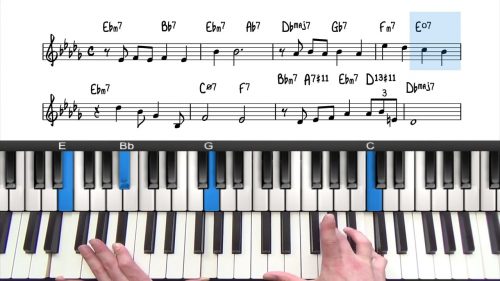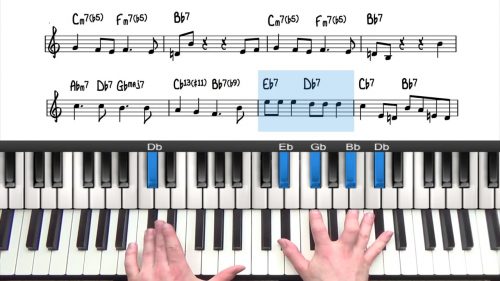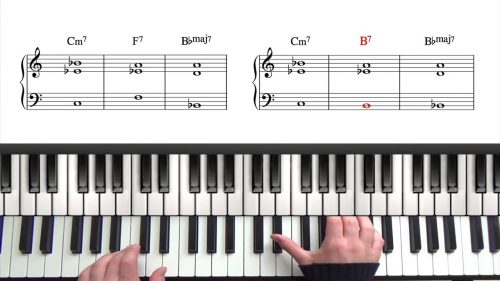Sophisticated Lady Stride Left Hand Style
In part 2 of this tutorial, we are going to explore the bridge of the tune and then add some melodic interest for the final A section.
The melody in the bridge is tricky to play in places because the notes fall on the off beats. The off beats are the & of each beat. Placing the melody on the off beats creates a very syncopated and swinging vibe… listen to the original recording of the tune to understand how much this tune swings.
We’re going to start with a basic stride style by playing the roots way down in the lower registers and then moving up with out left hand to play left hand voicings.
Then for the final A section we are going to explore some right hand patterns you can use to enhance the melody. We’ll be creating melodic ideas of out upper structures, 4^th^ intervals and octaves.
This is a challenging tune to play and so make sure you practice it slowly and accurately.
Practice Tips
-
Sophisticated Lady is a wonderful tune to explore upper structure triads.
-
Remember to print off the Upper Structure Triad Cheat Sheet which will help you find these voicings quickly and easily.
-
Try to memorise the chord tones contained in each upper structure triad. This will help you make more informed decisions when adding altered harmony to your arrangements.
- As an example, when the root is in the melody over a dominant chord, the #5#9 upper structure should come to mind which creates the #5, Root & #9. It's then down to you to find the most suitable inversion.







This has been the most challenging song I have learned from you. Great stuff.
Hey Adam 👋
Yes this is a tricky tune to learn, but also a very beautiful one!
The bridge is particularly challenging, partly because of the key change, and also the syncopated melody line. Listen to lots of different recordings and it will help you absorb the phrasing and placement of the melody over the chords in the B Section.
There’s a couple of important takeaways to remember from the lessons on Sophisticated Lady. When the root is in the melody over a dominant chord, there 2 nice options you always have available in terms of voicings:
1) The #5#9 Upper Structure Triad voicing… if you play a major triad off the #5, in it’s second inversion, you will have the root in the melody. Great to get that altered sound over a dominant chord with the root in the melody. This works in any key.
2) The sus13 chord – this also works well when the root is in the melody over a dominant chord. The formula is a minor 7th chord off the 9th – play this with your right hand. In the left hand you can play: R and b7, or R-4-b7. This formula also works in any key so it’s a good one to remember.
When you see a dominant chord with the root in the melody, you know that these 2 options will work.
With option (2) … You can then resolve the suspension to a dominant chord with an alteration which is a nice touch. Check out the lesson on Sus Chords for more info – you can find it in the “related lessons” box above.
Cheers,
Hayden
I am making excellent progress on this song. Is there another way to transition to the final A part of the song without doubling up the melody and playing those big voicings?
Hey Adam,
Yes you can play the 2nd line of the bridge just as we played the first line, so don’t double the melody.
I agree it’s hard to execute and perhaps a harmonically-simpler arrangement would have been better!
The chords in the last 2 bars of the bridge are unusual and also tricky to play.
If you have any versions you like the sound of, feel free to send them over and we can examine what is being played.
The minor II-V-I at the end of that line is important (C-7b5 and F7b9) as this progression pulls you back to Bb-7 to start the final A Section, so make sure you hit those chords.
Cheers,
Hayden
Thanks for responding. I was misplacing the chords on the swing. I had to slow it down in my midi player to understand what I was doing wrong. I will get the timing down eventually and it will become natural. There is a cover of this song that I listen to frequently on Youtube. Here’s the link:
. He also has a 2 part tutorial on this song. Have a great day.
His placements are bananas yet tasteful!
Wow beautiful arrangement Adam. Thanks for sharing.
You can see that in the 2nd line of the bridge, he keeps the single note melody line for most of it. Just like we did in the first on the first line.
Towards the end at around 1:18 – he’s playing some kind of upper structure harmony before returning to the final A section… I’ll take another listen later when I’m at my keyboard and let you know what he’s playing.
Cheers,
Hayden
Hi Adam,
I’ve been playing around with a simpler version of the Bridge – I will create a short video and upload to this course and in the forum.
The first thing to simplify is the left hand stride that I played in the arrangement. Just hitting shell voicings in the left also sounds great.
In the video you highlight above, the last bar of the bridge contains 3 upper structures over the F7 – all in their second inversion and all rootless too (in his left he is just playing b7 and 3 of F7… which is Eb and A)
The triads he plays over in his right hand are:
First an Ab Major Triad, 2nd inversion, to get C in the melody. This gives b7-#9-5 in the right hand… 5(C) is the melody.
Next we have Eb in the melody which is the b7 of F7, he plays a major triad off the #11 which is a B Major Triad and that gives you B(#11)-Eb(b7)-Gb(b9) … he then puts the Gb on the bottom so that triad is in it’s 2 inversion.
Finally he plays a major triad off the 13 which gives you the 13b9 sound. This is a D Major Triad – he plays in it’s 2nd inversion again to get the Gb on top and keep the original melody intact.
I’ll make a video on the simplified version shortly.
Cheers,
Hayden
I actually am getting down the version you posted. I have to keep at it until it feels natural, which it is becoming. Thanks for taking the time to respond to our requests. This song has a ton of rich chords. I cannot get enough. Thank you and God Bless!
That’s awesome. I will post the simplified version as other students have asked me similar questions about this tune, so I think that it would benefit others too :-)
Yes there is a lot of rich harmony in “Sophisticated Lady”. I chose it for this course because it helps students become more comfortable with upper structure voicings.
It’s unusual to have 4 consecutive upper structure voicings – as seen at multiple parts in the form – and so the tune is a nice ‘drill’ or ‘exercise’ to help students visualise this type of voicing technique.
Cheers,
Hayden
I am revisitng this tune and trying to vary it up a little. Did you ever get around to making the short video of the simplified bridge and turnaround?
Hi Adam,
Apologies for the delay… i will be recording new lessons over the weekend and next week and so I will make another version of the bridge for you.
This is one of the first tutorials I made and so I can definitely improve it. My arranging skills have improved a lot since then! :-)
Thanks for reminding me and I’ll get it done asap for you.
Cheers!
Hayden
Hi Hayden,
again, this is a very helpful lesson! Thanks a lot!
I have tried to figure out what happens in bar 24: The notation is “D13” – I guess, in the tutorial you choose a kind of Db13 voicing. I know other lead sheets which show an Eb7 here, instead. Could you give me a hint which which progression is “right”?
Thank you,
Karsten
thanks for the informative lesson. Could you elaborate on how should we call that chord (LH: 7-3-13, RH 9-5-1) with stacked 4th on the 9th in right hand. is there any definitive name or it’s rather just rootless quartal voicing of Dom.13? thanks in advance
Hi Alex,
Good question!
No there is no definite name that I know of. The easiest way to refer to it would be exactly as you say, a rootless left hand voicing with a quartal stack on top.
Here’s a couple of interesting things with these types of voicings:
Firstly it’s a great voicing for the blues, for example let’s say the the voicing you outline (LH: 7-3-13, RH 9-5-1) is a rootless F13 chord with the b7 at the bottom. If we change our left hand notes to D-Ab-C and play that same quartal stack on top, we then have a Bb13 with scale degrees 13-9-5 in the stack.
Another cool thing is is to again visualise this voicing as an F13 (LH: 7-3-13, RH 9-5-1), then move the right hand quartal stack up a half step, and we now have #9-#5-b9 which creates a very tense and dramatic comping chord
I hope that helps Alex.
Cheers,
Hayden
thanks a lot! the concept of switching from F13 to Bb13 while keeping stack of 4th sounds really cool to me. Going up a 0.5 tone as in your second example creates that feeling of being kinda ‘out’ of a key for a while. Besides, is there any lesson covering this topic? going out of a key for certain freshness. like Glasper likes a lot to through those parallel maj7 chords here and there.
best regards, Alex
Do you have a printed version of your transcription of Sophisticated Lady? I cannot find one. Thanks
Hi Edwin,
Apologies for the delay getting back to you here.
I will create a transcription of this arrangement as soon as possible. Leave it with me and I will email you once it’s done.
Cheers,
Hayden
Hayden, is there a transcription of SOPHISTICATED LADY? Would find it helpful to use for the practice.
Thanks.
Great instruction by the way.
Marc
Hi Marc,
If you check the comment section on part 1 of this lesson, you will see that one of our students shared the different voicing options that I play for the chromatic dominant sequence. Here’s the lesson page:
pianogroove.com/jazz-piano-lessons/sophisticated-lady-tutorial/ – scroll down to the comments.
A transcription wasn’t created as I don’t play a set arrangement in these lessons, instead I’m showing lots of different concepts and the many options that we have to voice the chords.
I will ‘stitch together’ a full transcription PDF file using the different fragments that I demonstrate and upload this to the downloads section of the page.
In the interim, please check out the student’s graphics posted in the comment section of the page referenced above and let me know if that helps.
Talk soon, cheers,
Hayden